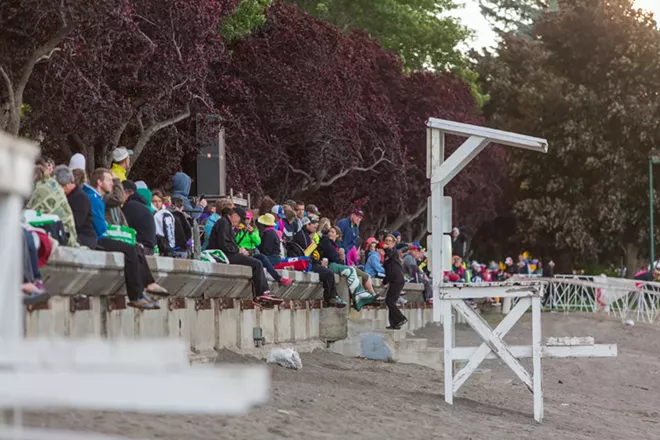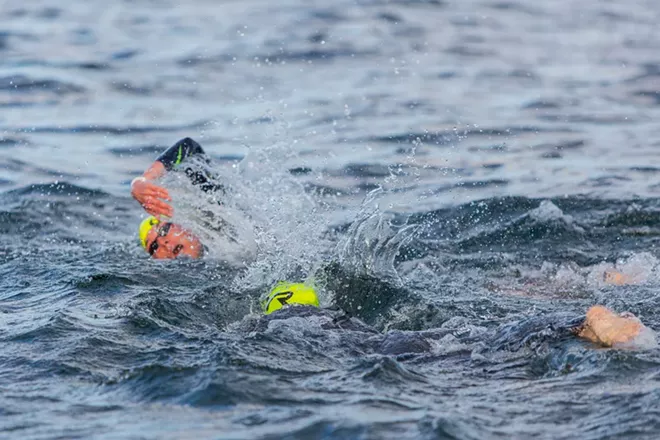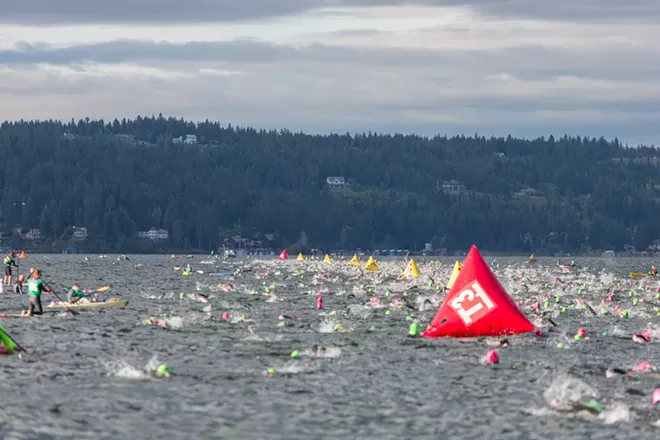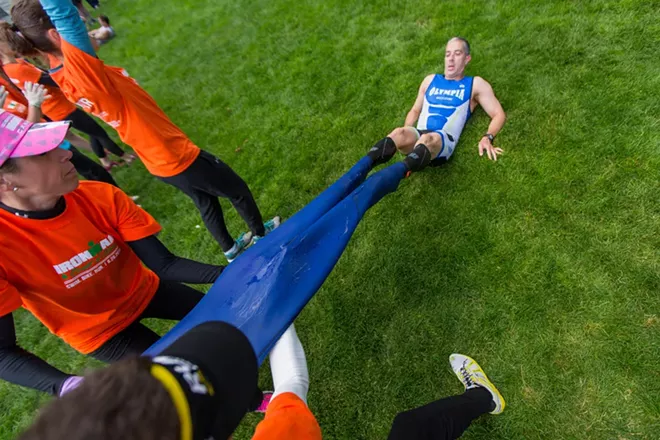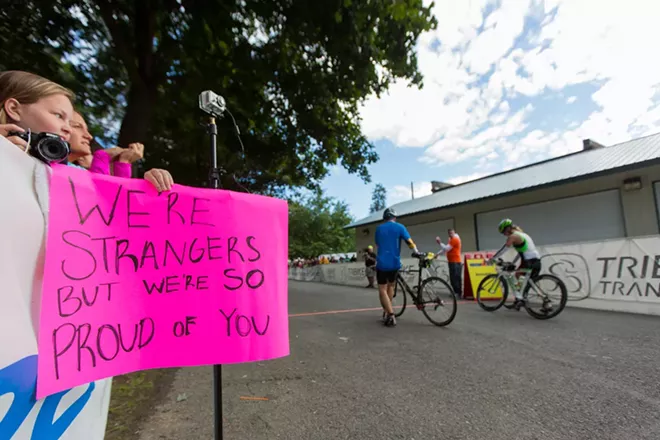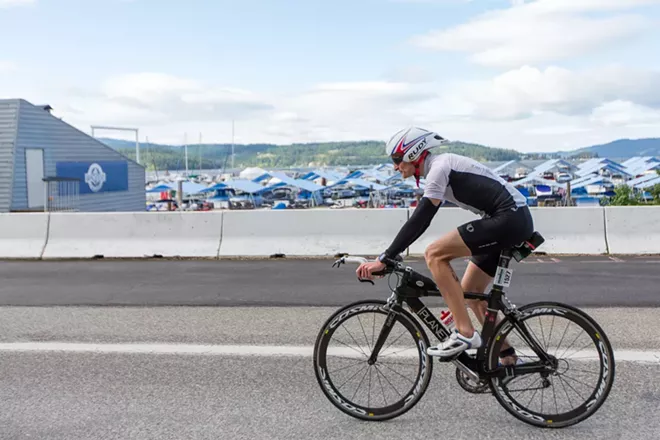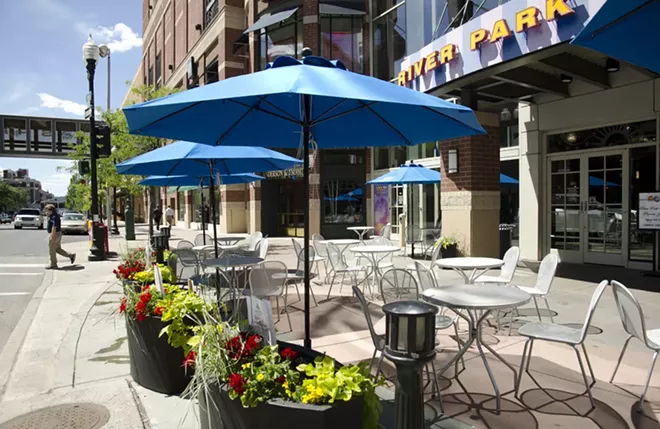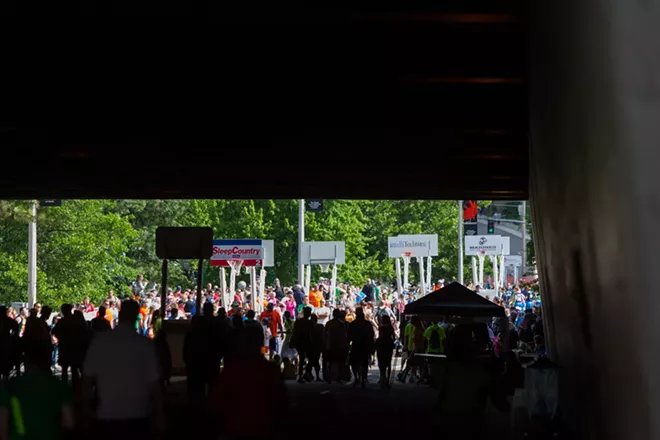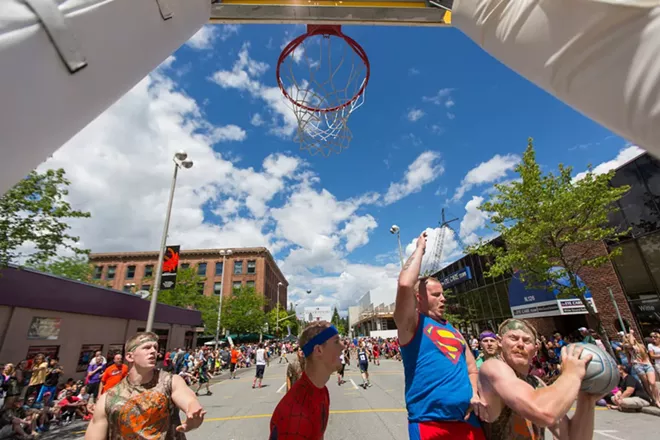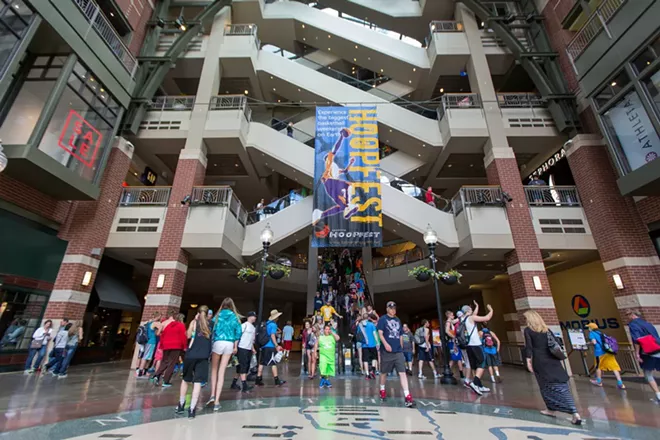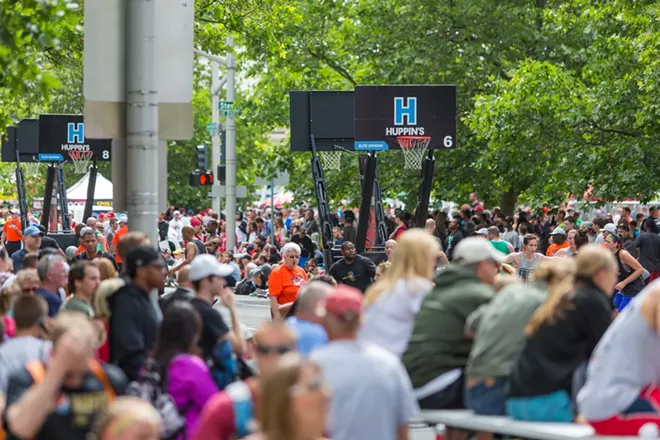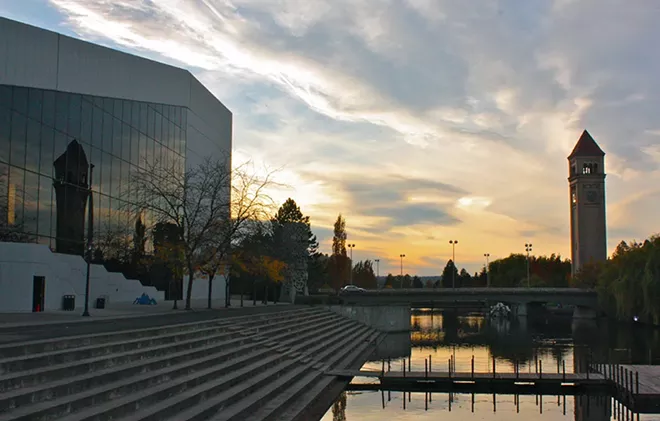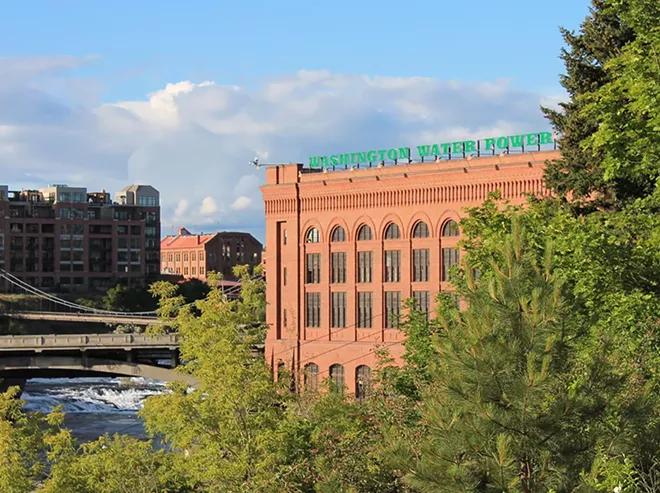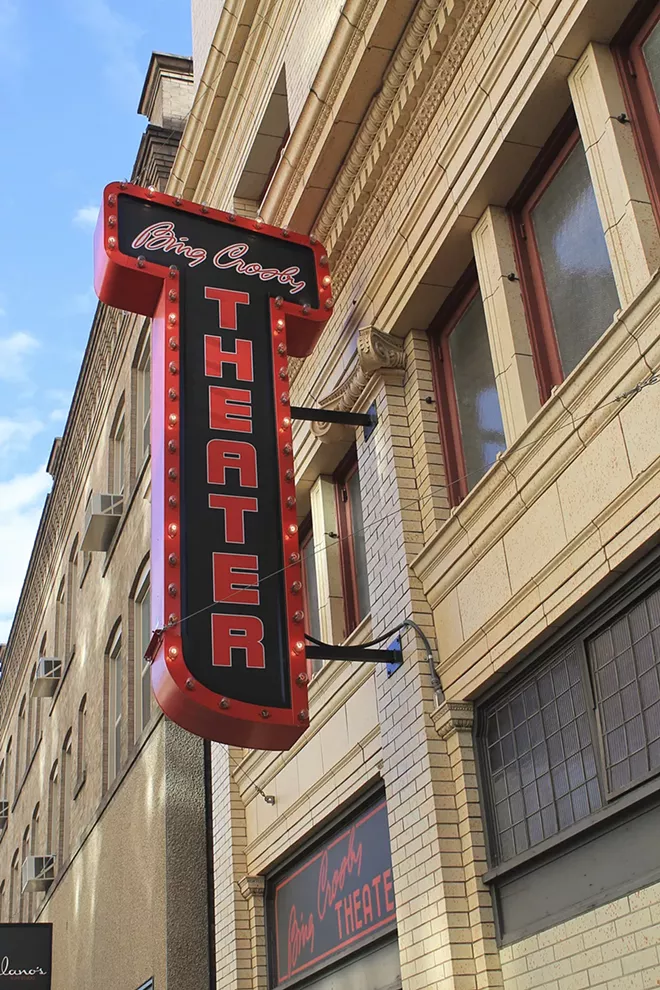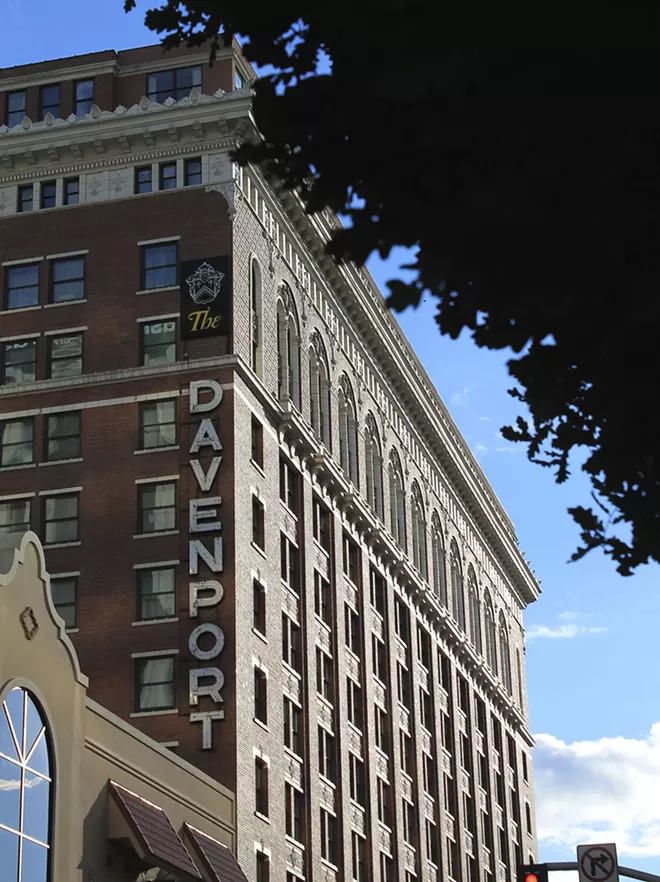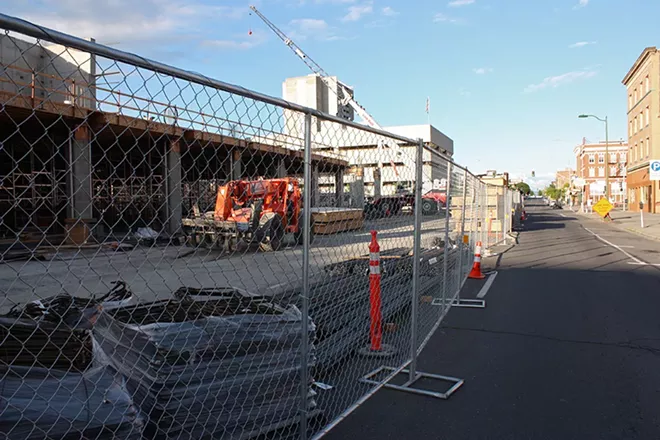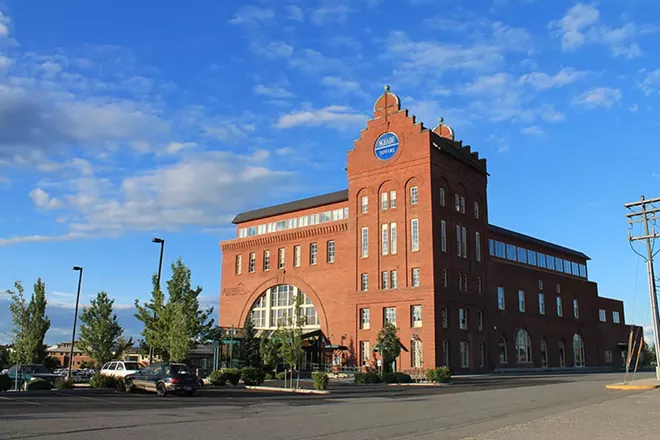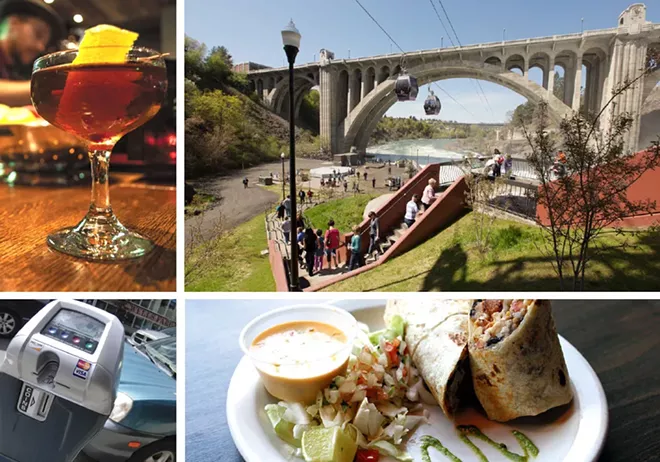Monday, June 30, 2014
On Sunday, the city and surrounding area of Coeur d’Alene turned into what women’s winner, Heather Wurtele, called “the easiest and hardest Ironman.” More than 2,460 athletes battled through choppy waters for the 2.4-mile swim, then biked through strong winds for the 112-mile bike ride and completed the 26.2-mile run. The weather was cool and breezy, perfect for the athletes competing this year. Andy Potts won the men’s professional division with a time of 8:25:44 and Wurtele won on the women’s side with a time of 9:34:32.
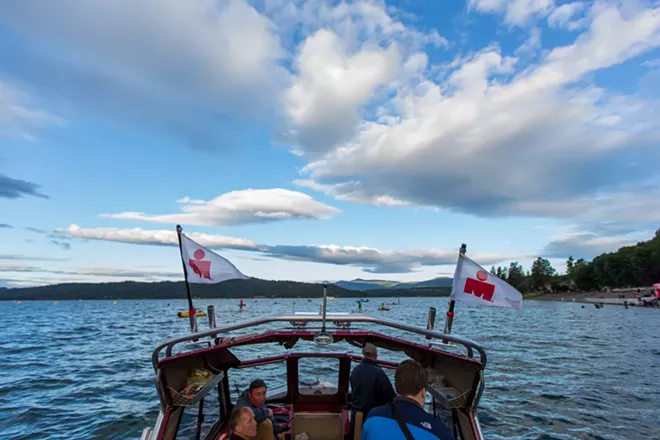
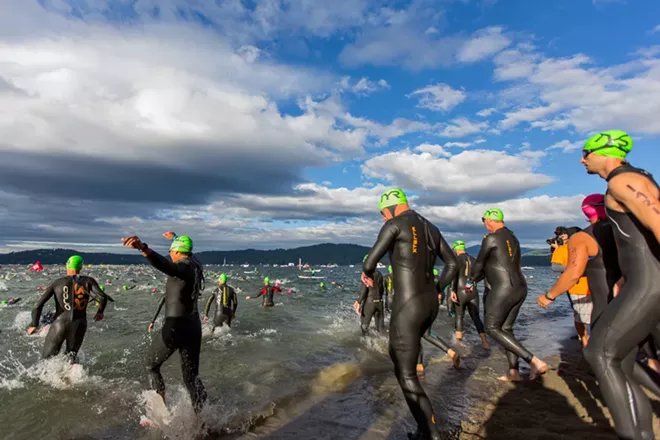
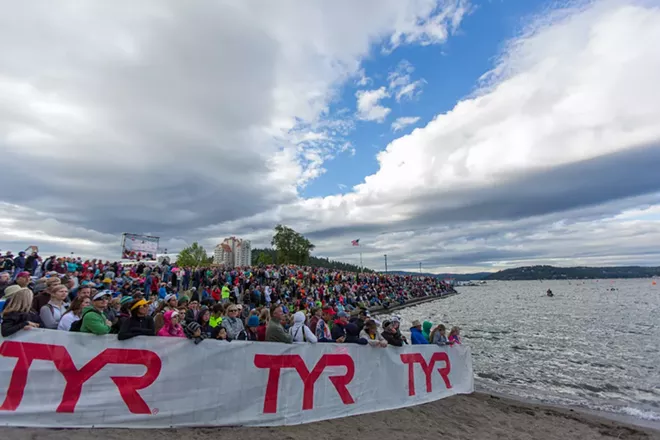
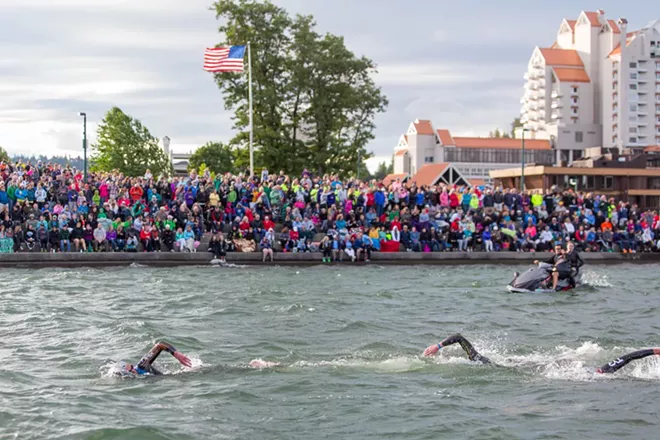


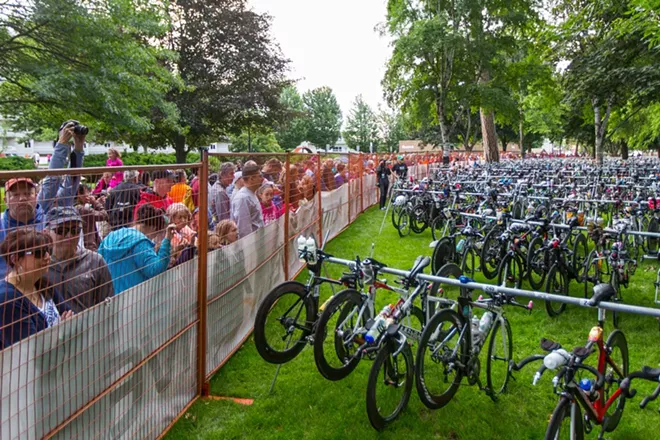

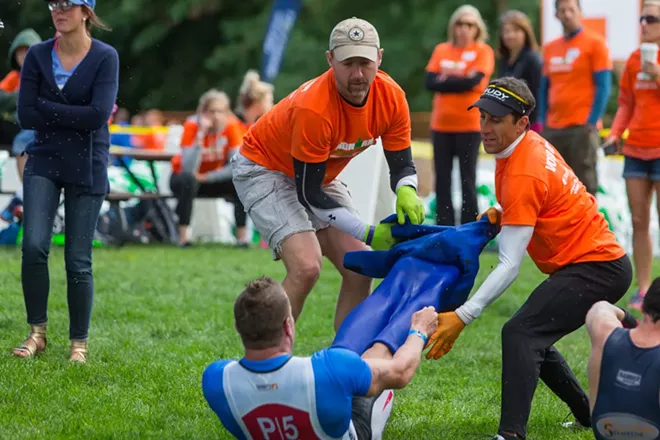


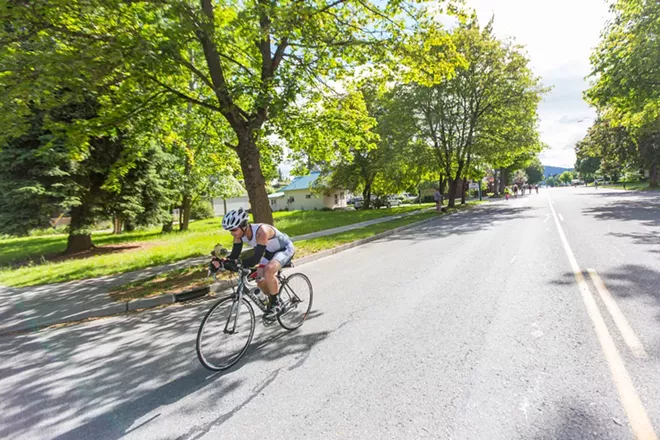
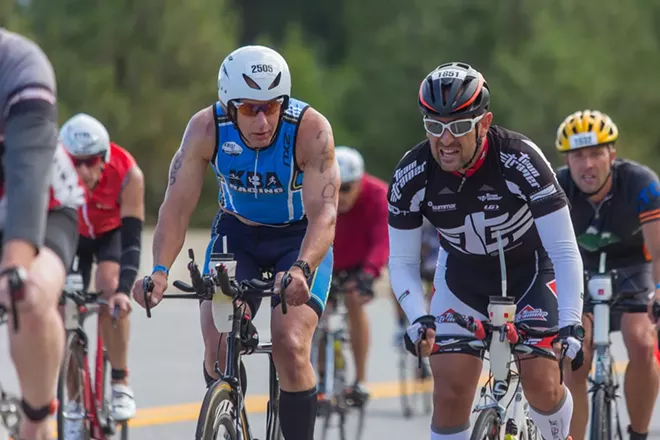



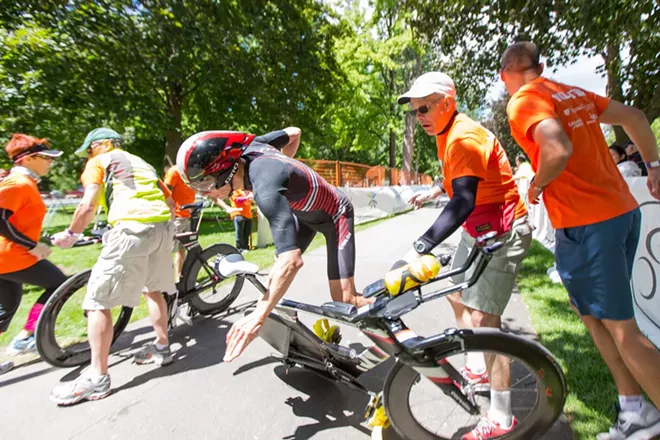




Tags: Sports , Photos , Ironman , Coeur d'Alene , Image
When does a corporation become human? Does it happen at conception, when the articles of incorporation are filed? Is it when the final member joins the Board of Directors or when they make the final change to the bylaws? The day they go public? Or does it happen when five out of nine Supreme Court justices decide that an obscure piece of the Constitution could be interpreted to mean that corporations are, and have always been, basically human in their function? Since the Citizens United decision in 2010, this absurd idea has become legal reality with effects that empowered the U.S. oligarchy to run rampant with no meaningful consequences.
As of this morning, the situation is even more strange. The Supreme Court defended the religious freedom of employers to deny birth control as part of their health benefits offered. As Justice Ruth Bader Ginsberg wrote in her dissent, “The exercise of religion is characteristic of natural persons, not artificial legal entities.” She is consistent and correct in noting that a corporation is an artificial legal entity. It does not breathe, eat, reproduce or get sick. One would hope that this point wouldn’t require clarification, but this is a world where a CEO’s imaginary friend’s feelings just became more important than my health, your health, and the health of your daughters, wives, sisters and friends.
All laws are a fiction to some extent. They are written by people in an attempt to give structure to the unpredictability and danger of life, but often backfire and eventually, as is true in this case, become so detached from real reality that they’re rendered meaningless. Sure, the federal government will likely adjust to provide the contraceptive coverage that’s been exempted from these few companies, but the point here is less about the specific instance of absurdity and more about the size of the pile of absurdity it’s landed on.
The decision also highlights one of the main issues with large scale indirect governance. Power is shared equally within the power structure regardless of expertise, background or understanding. Predictably, the majority who supported this decision are all men. Once again, men make decisions about women’s bodies and health from the comfortable distance of legal abstraction in the same way that the overwhelmingly wealthy seem to find it easy to cut so-called entitlements for the working poor while also destroying opportunities to leave those programs.
In such an unbalanced system, where millions of people can be affected by the bad decisions of a few, being accurate doesn’t even appear to matter. Justice Samuel Alito, who authored today’s decision, claimed that it would not “provide a shield for employers who might cloak illegal discrimination as a religious practice.” When women are the only group directly targeted by a law, it is a discriminatory law on the basis of sex. This type of discrimination is illegal. Imagining that an individual’s religious practice should have any bearing on any other person’s life is bizarre and disturbing. Despite the dissonance, that’s just the way things work around here, unless we decide to stop giving our power away to the most delusional among us. ♦
Taylor Weech, who hosts the weekly public affairs program Praxis on KYRS-FM, is a Spokane writer and activist. She's advocated, among other things, for environmental sustainability and all-ages access to the arts. She shares writing, photography and her podcast at truthscout.net.
Tags: commentators , Supreme Court , Comment , Image
Way back in January when it was too cold to care much, we wrote about how letting businesses spill into the sidewalk with sandwich boards, music and patios can make cities more pedestrian-friendly and lively. (And that means safer, too.)
In Spokane, businesses that want to build a café area on the actual sidewalk — as opposed to private property that happens to be outside — must apply for a permit from the city. Among the requirements: The patio must leave at least 6 feet of unobstructed sidewalk, must not block deliveries for adjacent businesses and must be at least four feet from any street trees.
And the city has quite a few new ones this year. Now that we’ve got some summery weather, here’s the list from the city of all businesses newly permitted this year for their inaugural sidewalk café summer:
River Park Square
808 W. Main Ave.
A seating area outside the front entrance of the mall is bordered by new flower planters, and a popular place to pause with an iced coffee.
The Bartlett
228 W. Sprague Ave.
The wood-fenced patio was just constructed in the past week, and nearly doubles the seating capacity of the music venue’s café area.
The Blind Buck
204 N. Division St.
Partially covered by the bar’s awning, the little patio out front on Division is bordered by a tiny ledge just wide enough for your cold drink.
Wild Dawgs
102 N. Howard St.
The patio outside Wild Dawgs, in the shadow of the Parkade, has full-size tables and feels urban without too much traffic.
River City Brewing
121 S. Cedar St.
On the west end of downtown just up the block from Rocket Bakery’s big outdoor seating area, River City’s patio is a good spot for watching the sun set as trains go by.
Wisconsinburger
916 S. Hatch St.
Located in a residential part of the Perry District — the only one on this list outside the downtown core — Wisconsinburger built a wood deck across the full front of the restaurant.
Tags: outdoor dining , patio , Culture , Food , Arts & Culture , Image
We're working on a series of stories all about the new recreational marijuana market in Washington: who's behind it, how to find it and how not to break the law. Now, we want your help.
Go here or use the form below to share your (true, please) marijuana memories — best, worst or somewhere in between. We'll allow you to be anonymous in the paper, but if you're OK with us using your initials or other basic information, we'd love that too. All the details are in the survey below and you can send any questions to heidig@inlander.com. We need your stories by Friday, July 4.
HERE
Finishing the 140.6-mile triathlon with the fastest times, Andy Potts of Colorado Springs and Heather Wurtele, from Canada, won the Ironman Coeur d’Alene on Sunday. (S-R)
Former Spokane police chief Anne Kirkpatrick is leaving her post at the King County Sheriff’s Office to work for the FBI. (Seattle Times)
More than 6,000 teams played on 458 courts this past weekend for the 25th annual Hoopfest. Check out our photos of the festivities. (Inlander)
THERE
In a 5-4 decision this morning, the Supreme Court sided with Hobby Lobby, ruling that employers with religious objections are not required provide contraceptive coverage under the Affordable Care Act. We interviewed U.S. Sen. Patty Murray about the case in April. (BuzzFeed/Inlander)
President Obama is expected to tap Robert McDonald, the former CEO of Procter & Gamble, to run the scandal-ridden Department of Veterans Affairs. (WaPo)
This isn't creepy at all: For a week in January 2012, Facebook data scientists manipulated nearly 700,000 users' news feeds to study how "emotional states can be transferred to others via emotional contagion." (Atlantic)
Tags: News , Morning Briefing , Image
Saturday, June 28, 2014
On Saturday, the streets of downtown Spokane turned into the street basketball headquarters of the world, with 42 city blocks taped over for the nearly 7,000 teams expected to play in the 25th Hoopfest. Players and spectators alike enjoyed the sun and cool breeze that swept through downtown all day.


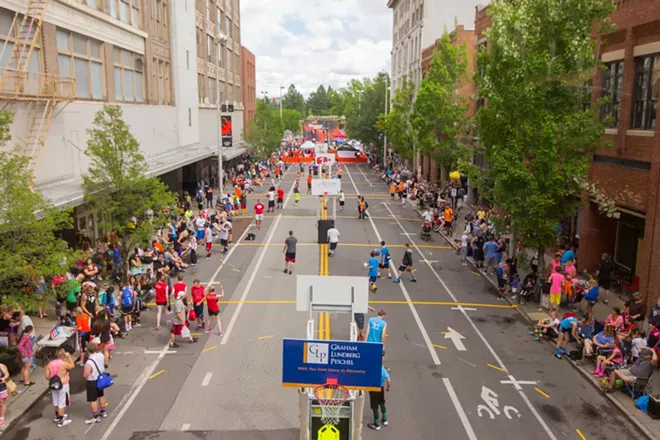
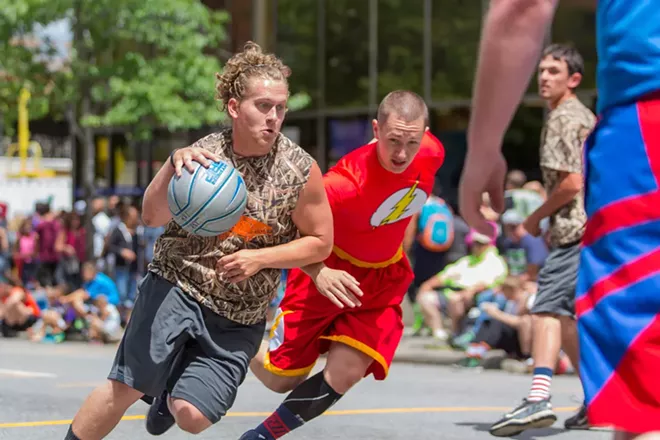
Tags: Photos , Sports , Culture , Hoopfest , Arts & Culture , Image
Friday, June 27, 2014
Read more about the Northwest Museum of Arts & Culture's 100 Stories — A Centennial Exhibition exhibit in this week's cover section. The first 15 "stories" in the exhibit are located off the museum campus, around Spokane and the region. Here, we take you on a visual tour of exhibit highlights in the downtown core. To take the tour yourself, visit the Spokane Historical website or download the app, and choose the 100 Stories tour.
Expo ’74 was the first stop on our expedition through some of the 15 off-campus sites. As most residents know, the site of the World's Fair was converted into Riverfront Park and hosts some of the most recognizable structures in the city, such as the giant U.S. Pavilion. This structure currently shelters an assortment of carnival rides in the summer months and an ice-skating rink during the winter. But these events and rides are only a fraction of the grandiose entertainment that occurred in the park in 1974.
We continued to stroll through Riverfront Park, now under consideration for future reconstruction, and in the process passed by several other structures that trace back to the World’s Fair production: the Convention Center, formerly constructed as the Washington State Pavilion, and the Looff Carrousel building along the edge of the south channel of the river.
This World’s Fair Exposition in part provided access and interest in the Spokane River, its gorge-like drop-offs, and the power of the downtown falls. But for the century prior, the river had been a source of energy that the city capitalized upon.
The Washington Water Power Company formed in 1889 to respond to a demand for electricity in the growing city of Spokane. They developed hydroelectric power plants along the Spokane River, and quickly overtook any smaller energy generation plants in the area. The power station, located near Monroe Street Bridge within the spray zone of the lower falls, is an idyllic view from the newly constructed Huntington Park.
Following Monroe directly south from the park, we paid a visit to the Fox Theater. Construction of the theater, whose uniquely concrete design was referred to as futuristic at the time, occurred in the years following the stock market crash of 1929, and helped employ several hundred Spokane residents. Bringing 30,000 residents to the streets on its opening night in 1931, it is now home to the Spokane Symphony orchestra.
Sparing no expense, the Clemmer Theatre, now known as the Bing Crosby Theater, was built with the new idea that the ambiance of a theater was as important as what was being shown on its screen. Opening its doors in 1915, the theater has had a few other names since the Clemmer — the State, the Met, and finally the Bing Crosby. A total of 744 seats provide the opportunity for many to still enjoy live performing arts along with screenings of films.
A half block down and a quick dash across the street, we entered the 100 Stories tour's next historic location. Walking through the revolving doors into the impressive and lavish interior that is the Davenport Hotel, it's not hard to picture what the landmark looked like when it opened in 1914. Following the great fire of 1889, Louis Davenport found the restaurant he had been leasing from his uncle destroyed. He opened a “Waffle Foundry” that he later relocated and renamed Davenport’s Restaurant. After acquiring the three-story building next door, he made plans to demolish the existing buildings and begin building plans. After facing an unpredictable future, the Davenport was purchased by Walt and Karen Worthy and underwent a complete restoration in 2000. It now continues to serve as a central gathering place with much of its original ambiance and design.
Located on the eastern side of downtown, Trent Alley was once full of noodle houses, barbershops, hotels, fish markets, pool halls and other small businesses that were owned mostly by Japanese and Chinese entrepreneurs, and thrived previous to the Great Depression. Several of the businesses were documented by photographer Ryosuke Akashi, telling the stories of these entrepreneurs' working lives, as well as rumored ghost tales in the area. Several decades later, the core of the district was flattened and paved into a parking lot for Expo '74. Now, the new Convention Center hotel being built by Walt Worthy is taking form in the block bordered by Howard and Bernard streets and Spokane Falls Boulevard and Main Avenue.
Walking a little east of central downtown, a once booming brewery is now full of slightly less noisy happenings. Erected in 1903, Schade Brewery/Tower initially produced 35,000 to 40,000 barrels a year. During Prohibition, the Inland Northwest was full of those seeking and supplying alcohol because of Canada's proximity. Bernhardt Schade served as the brewmaster who bought the entire block on East Trent on which to construct the brewery, bottling building, and steam/pump house all with European inspirations. Though still occupied, the brewery now houses offices and retail.
All near the central downtown stretch of the city, these sites connected us to the development and history of Spokane through the last century and beyond. Walking to all of these locations provides for a relaxing afternoon reflecting on the region's history and how that past has contributed to the present.
Tags: Culture , 100 Stories , Northwest Museum of Arts and Culture , Spokane Historical , Arts & Culture , Image
What a beautiful summer day we’re having… Maybe not so much, but there’s always room for live music in a warm place.
FRIDAY
Seattle’s Witchburn is the sort of band that makes you feel deeply all while making your ears ring quite loudly — they’re sludge rockers with a violinist, yes. They play the Hop! tonight with Wild Throne, Ape Machine and Project Kings starting at 8 pm. The all-ages show is $10.
True, string-based folk groups are all the rage right now in the Northwest, but don’t hold that against Seattle-based Blackberry Bushes String Band. They play Jones Radiator on Friday and Saturday night.
EDM paradise Paradiso festival starts today. Even if you can’t make the Gorge festival this weekend, there’s plenty more regional festivals happening all summer.
SATURDAY
Cruisers hosts Stateline Music Fest Saturday starting at 1 pm. The show features all these bands: Invasive, Vile 8, project Kings, Seeds, Weary Traveler, Seven Cycles, 5 Times Over, Free the Jester, UnderCard, Hostile Approach and more. Tickets are $15 at the door.
Spokane experimental groups Loomer and Space Movies, along with Portland dream pop act Appendixes, offer a weird and wonderful experience Saturday night at the Big Dipper. The all-ages show starts at 9 pm.
HOOPFEST
Hoopfest is happening all weekend baby and there is plenty of live music to go right along with it. Saturday night, the Viking Bar is throwing a Hoopfest Parking Lot Party feat. Death By Pirates, Drop Off, Dead Serious Lovers and Jack Parker. Sunday night, the Red Room Louge is throwing a Hoopfest weekend party with Seattle rapper Nacho Picasso headlining. That show is $10 the day of and starts at 9 pm.
SUNDAY
Rockers the Everymen travel to the Baby Bar this Sunday all the way from New Jersey while on tour for their new album Givin' Up On Free Jazz. Fun Ladies open for the free show that starts at 9 pm.
Tags: Local music , this weekend in music , Hoopfest , Witchburn , Nacho Picasso , Music , Image , Video
When downtown Spokane’s streets transformed into basketball courts last year, the Inlander was still located in the Hutton building on Washington Street. That reminded us just how much has changed in the past year, so here are some of the highlights you’ll notice this weekend if you haven’t walked Spokane's downtown streets since last year’s Hoopfest.
1. Huntington Park and the Centennial Trail
The newly renovated Huntington Park has only been open a month, but it connects with Riverfront Park so seamlessly that visitors could easily think they remember it being that way forever. The overlook on the south side of the falls is owned by Avista, and late last summer the power company closed off the whole area for renovations that include better access, art installations and more informational signs about the area. The most visible difference is the plaza by City Hall, right across Post Street from Riverfront Park, which is still in the process of getting a name.
About the time the park closed for renovations, the Centennial Trail opened on the north side of the river through the new Kendall Yards neighborhood, including an underpass beneath the Monroe Street Bridge. Stick to the right side of the path under the bridge, where the roar of the falls makes it hard to hear approaching bicycles.
2. Those walls by the Convention Center and other construction
It’s hard to miss the massive construction project near the Convention Center, which has been closing lanes and sidewalks all year. The former parking lot first became a giant hole in the ground, and is now beginning to take shape as a giant hotel. It’s a project of Walt Worthy, who also owns the Davenport, and it’s planned to open next summer as a modern hotel with more thant 700 rooms and a direct connection to the Convention Center.
That’s not the only construction downtown, though — nearby on Main Avenue the historic Bennett Block is under renovation. Former Bennett Block tenant Spokane Exercise Equipment moved a block to the east, which is also a hub for big renovations after two longtime businesses — Huppin’s and Dutch’s — closed last year. Madeleine’s will be moving there, and the owners are also opening another place called Durkin’s Liquor Bar.
Farther down on Main, the former Merlyn’s (which moved next door) is under construction to become a new market-style building with a brewery, bakery and other businesses. And up on Sprague near the Davenport, the historic Germond Building is also being renovated for apartments upstairs and retail at street level.
Since the Inlander moved out of the Hutton Building, the lower floors have been renovated to become the downtown hub for STCU, and the upper floors are under construction. Ground floor tenant Sweet Frostings Blissful Bakeshop is doing its own expansion and renovation right now, but remains open through construction.
3. “Smart meters” for street parking
After talking about it for a while and researching the best systems, Spokane finally got “smart meters” that let you pay for street parking with a credit card. This is great if you don’t have pocketfuls of loose change on you, but note that paying with card means there’s a minimum payment of $1.20 (an hour). The smart meters are concentrated near the center of downtown. The city has also been adjusting the time limits at some meters around the fringes of downtown, so don’t be surprised if that old 10-hour meter is now labeled 4-hour or “All Day.”
4. A smaller visitor center in the mall
If you try to stop by the old visitor center at the corner of Main and Browne, you’ll find an empty building. Late last year, Visit Spokane decided to forgo the permanent center in favor of more flexible outreach. In other words, if it’s traditional brochures and advice you’re looking for, stop by the Visit Spokane welcome kiosk on the ground floor of River Park Square.
5. Ramen, brunch and other new eats
We do our best to keep track, but the downtown restaurant scene has been crazy with openings (and closings and reopenings) in the past year. Entirely new is Nudo, a ramen house where Berg’s Shoes was located for many decades. Pho City opened right around Hoopfest last year, and Wild Dawgs reopened with new owners next door later in the year. Ciao Mambo closed and reopened as a MacKenzie River location, and Mi Casa recently opened near the Plaza in the former Rex’s Burgers space. It’s maybe best known for its bar, but Borracho Tacos & Tequileria opens early for breakfast burritos and, recently, all the World Cup games.
On the other side of the river, Kendall Yards had only Central Food at this time last year. Now there’s the Yards Bruncheon and the Wandering Table, plus Brain Freeze Creamery. Nearby, Irish pub and restaurant Knockaderry opened in the former Sidebar location by the courthouse.
6. Cocktails, cider, root beer and other new drinks
A lot of new breweries, distilleries and nightlife spots have been popping up beyond the downtown core, but there’s plenty new to sip downtown. Last July, the venerable Blue Spark shut its doors and the space was quiet for a while, but about a month ago the space reopened as a new bar, Underground 15. Downtown Spokane’s first cidery, Liberty Ciderworks, opened its tasting room in April, and Walla Walla-based winery Patit Creek Cellars opened a tasting room on Sprague.
For cocktails, the Blind Buck opened in a speakeasy-style space next to the still-empty Globe late last summer, and the Volstead Act opened with vintage-style cocktails not long after. Santé also added a bar to its restaurant space, called the Butcher Bar. After opening the brewery side of things early last year, River City Brewing added a taproom in the fall — and, since it’s kid-friendly, they also serve a housemade root beer. If you don’t have time to catch a show at the Bartlett, you can stop by the music venue’s small cafe for coffee or happy hour.
Tags: Culture , For Fun! , Arts & Culture , Image
AROUND HERE
The man wounded in a shootout with police on I-90 has been charged with one count of eluding a police officer. (SR)
A witness says armed EPA agents raided Hayden plumbing company The Rooter Guys, Thursday. But authorities won't say why. (CdA Press)
Yesterday's rain caused flooding at Interplayers Theatre. (KREM)
Fairchild, WorkSource Spokane and the Spokane Area Workforce Development Council will team up to help veterans find jobs. (KXLY)
North Idaho police have found a man they say tried to strangle a woman in her travel trailer on Saturday. (SR)
ELSEWHERE
Ukraine has signed a trade agreement with the European Union, angering Russia. (NYT)
A D.C. think tank's new report says secretive U.S. drone use damages legal and moral norms around the world. (Al Jazeera)
You've been hearing about a lot of unaccompanied children crossing into the U.S. illegally. Here's an explainer of what you need to know about the issue. (Vox)
The U.S. will not produce or purchase any more deadly land mines, but some say the country should do more. (WaPo)
You're paying about 13 percent more for bacon than you were at this time last year. Thank a deadly pig disease. (NPR)
Tags: morning briefing , News , Image


